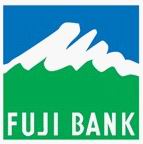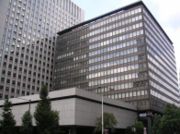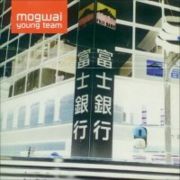富士银行
出自 MBA智库百科(https://wiki.mbalib.com/)
目录 |
2000年9月29日由富士银行、第一劝业银行和日本兴业银行组成日本瑞穗金融集团,于2003年1月成立。
日本富士银行 (株式会社富士银行,日文:Kabushiki-gaisha Fuji Ginkō,英文:The Fuji Bank, Limited,简称Fuji Bank)。
日本富士银行是日本和世界大商业银行之一,是日本芙蓉企业集团(富士集团俗称)的骨干企业之一,集团成员还包括众多日本及世界驰名企业,如佳能、日立、日产汽车、雅马哈、丸红等。
富士银行的前身是1863年安田善次郎开设的安田屋兑换店。1866年,安田屋改名为安田商店,并逐步扩大了经营范围。1880年安田商店改称合平安田银行,除继续经营兑换业务外,又扩大了存款、放款业务。1900年,改名为安田银行。1923年11月合并了安田系统的11家银行后,成立了新安田银行,是当时日本规模最大、实力最雄厚的银行。1943年4月,安田银行合并了日本昼夜银行,1944年8月又合并了昭和银行和第三银行。1946年9月,安田财阀的最高领导机构——安田保善社被解散。作为安田财阀核心的安田银行也被解散。1948年4月,驻日美军当局提出银行不适用集中排除法,安田银行原封不动地得到恢复。同年10月,安田银行在改名富士银行后重新开业。
富士银行从事的业务主要有存款、贷款,有价证券投资,国内汇兑,国外汇兑,公司债的受托和登记;兼营业务主要有代理、保管、有价证券的贷款、债务保证等。
到1987年3月底止,富士银行在国内拥有249家分支机构,在国外设有14家分行和32个办事处。以富士银行为核心的芙蓉集团还有29家直系公司和54家旁系公司。
富士银行非常重视中国业务,也是最早开展中国业务的日本银行之一,1972年至今,富士银行高层频繁访华,多次受到国家领导人的接见。银行现已同中国最主要的24家银行和信托公司签订了业务合作协定。1982 年至今,在中国举办了大量金融课题研讨会,并邀请大量中国各方人员赴日研修培训。富士银行现在中国大陆设7个分支机构,遍布中国东北、华北、华东和华南地区,并在中国设立了2家日中合资企业。
Foundation and Development(成立与发展)
Fuji Bank traces its history as far back as the old Yasuda zaibatsu.
In 1864, twenty-one year old Zenjiro Yasuda migrated from Toyama to Edo, settling in Nihonbashi, where he opened a dry goods store, simply titled Yasuda-ya (lit. Yasuda & Company). After the Meiji Restoration in 1869, the company positively underwrote bonds for Japanese government, whose credit standing was low then, and restore large treasury surplus. The company also financed many public works such as railroads, harbor constructions, and so forth.
The company became incorporated in 1880, with a solid capital of 10 million yen accumulated in Yasuda-ya period, and changed its name to Yasuda Bank. In Taishō period, the Japanese banking community were thrown into financial difficulties because of World War I and 1923 Great Kanto earthquake. Yasuda Bank aided many minor, small or medium banks, 11 of which were merged into Yasuda Bank in 1923. This merger helped Yasuda Bank become the largest Japanese bank in terms of deposits.
After World War II(二战后情况)
Following World War II, Yasuda zaibatsu were dissolved by the SCAP. On October 1, 1948, Yasuda Bank changed its name to The Fuji Bank, Limited. “Fuji” was named after Mount Fuji, which is a world-famous symbol of Japan, Fuji Bank aiming to be a world-famous Japanese bank. Fuji Bank formed Fuyo Group, one of the largest keiretsus, together with former Yasuda zaibatsu companies.
As the Japanese economy developed, Fuji Bank expanded its business, with leadership positions in syndicated lending, corporate banking, public money management, mortgages, and retail financial services.
Decline and Merger(衰落与合并)
In 1970s, Sumitomo Bank began to gain market share at Fuji Bank's expense in the retail banking. Fuji impatiently entered into rivalry with Sumitomo. In the later 1980s, however, the Japanese asset price bubble comes, and the Japanese banks granted increasingly risky loans. After the bubble's collapse, Fuji's progressive plan also backfired. Fuji lost a great deal of money, swamped by non-performing loan.
In order to find a way out of the difficulties, Fuji Bank attempted to diversify its services, establishing Fuji Securities and Fuji Trust & Banking Co. in 1994. These subsidiaries, however, didn't make so large a profit. Meanwhile, Fuji Bank had to restructure, lay off thousands of employees and sold its 52% stake in Heller Financial to GE Capital.
A very successful derivatives sub company, Fuji Capital Markets Corp was founded in New York in 1990 going on to become one of the lead players in the swaps market. FCMC went on to open an offices in London in 1992 and Hong Kong in 1994 which still exist as Mizuho Capital Markets Corp. FCMC was noted at the time for its relatively advanced technology, and was one of the first Japanese Banks to connect to the internet, registering the fcmc.com domain in 1993.
On November 24, 1997, Yamaichi, Fuji Bank's affiliated securities firm, announced it would cease operations and was declared bankrupt by the Tokyo District Court. In addition, Yasuda Trust & Banking, Fuji Bank's affiliated trust company, ran into problems with earnings and credit quality in 1999. Fuji Bank bought a controlling stake in Yasuda Trust, but Fuji couldn't reconstruct Yasuda for itself any longer .
Just in time, Dai-Ichi Kangyo Bank proposed to Fuji its becoming a “white knight” for Fuji. Dai-Ichi Kangyo held superior assets, but was left behind the current of the Japanese banks mergers. Fuji Bank weakened by its non-performing loan had no choice but to merge with Dai-Ichi Kangyo, along with the Industrial Bank of Japan, creating Mizuho Financial Group in 2000.
During the September 11, 2001 attacks on New York, Fuji Bank's United States offices were located at the impact zone of United Airlines Flight 175 in Tower 2. Fifteen Fuji Bank employees died in the attack.
| 本条目仅是MBA智库百科对富士银行的介绍。若您需要与富士银行联系,请访问富士银行官方网站。 |










